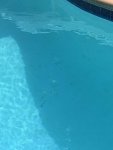Howdy,
This is an ongoing issue, which I think is getting worse, but my wife disagrees. She does most of the vacuuming. There are several areas around the pool where this occurs, mostly in the deep end. This are brownish stains.
This is the second year of TFP. I replaced about half of the water last year due to really high CYA after properly testing the water. Also, I'm relatively sure a lot of copper got put in the pool early last season by the "pool guys" (before we fired them) when they cleared up the green water.
I maintain the FC at 4ppm, Ph about 7.5ish (add about a pint of acid every day.
TA=100 CH 270 CYA 40
Brushing with stainless steel doesn't help.
Thanks
This is an ongoing issue, which I think is getting worse, but my wife disagrees. She does most of the vacuuming. There are several areas around the pool where this occurs, mostly in the deep end. This are brownish stains.
This is the second year of TFP. I replaced about half of the water last year due to really high CYA after properly testing the water. Also, I'm relatively sure a lot of copper got put in the pool early last season by the "pool guys" (before we fired them) when they cleared up the green water.
I maintain the FC at 4ppm, Ph about 7.5ish (add about a pint of acid every day.
TA=100 CH 270 CYA 40
Brushing with stainless steel doesn't help.
Thanks
Attachments
Last edited:



